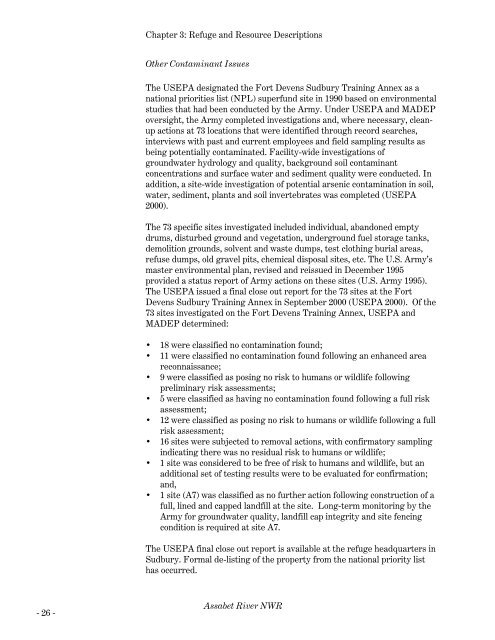Assabet River NWR Final CCP - U.S. Fish and Wildlife Service
Assabet River NWR Final CCP - U.S. Fish and Wildlife Service
Assabet River NWR Final CCP - U.S. Fish and Wildlife Service
Create successful ePaper yourself
Turn your PDF publications into a flip-book with our unique Google optimized e-Paper software.
- 26 -<br />
Chapter 3: Refuge <strong>and</strong> Resource Descriptions<br />
Other Contaminant Issues<br />
The USEPA designated the Fort Devens Sudbury Training Annex as a<br />
national priorities list (NPL) superfund site in 1990 based on environmental<br />
studies that had been conducted by the Army. Under USEPA <strong>and</strong> MADEP<br />
oversight, the Army completed investigations <strong>and</strong>, where necessary, cleanup<br />
actions at 73 locations that were identified through record searches,<br />
interviews with past <strong>and</strong> current employees <strong>and</strong> field sampling results as<br />
being potentially contaminated. Facility-wide investigations of<br />
groundwater hydrology <strong>and</strong> quality, background soil contaminant<br />
concentrations <strong>and</strong> surface water <strong>and</strong> sediment quality were conducted. In<br />
addition, a site-wide investigation of potential arsenic contamination in soil,<br />
water, sediment, plants <strong>and</strong> soil invertebrates was completed (USEPA<br />
2000).<br />
The 73 specific sites investigated included individual, ab<strong>and</strong>oned empty<br />
drums, disturbed ground <strong>and</strong> vegetation, underground fuel storage tanks,<br />
demolition grounds, solvent <strong>and</strong> waste dumps, test clothing burial areas,<br />
refuse dumps, old gravel pits, chemical disposal sites, etc. The U.S. Army’s<br />
master environmental plan, revised <strong>and</strong> reissued in December 1995<br />
provided a status report of Army actions on these sites (U.S. Army 1995).<br />
The USEPA issued a final close out report for the 73 sites at the Fort<br />
Devens Sudbury Training Annex in September 2000 (USEPA 2000). Of the<br />
73 sites investigated on the Fort Devens Training Annex, USEPA <strong>and</strong><br />
MADEP determined:<br />
18 were classified no contamination found;<br />
11 were classified no contamination found following an enhanced area<br />
reconnaissance;<br />
9 were classified as posing no risk to humans or wildlife following<br />
preliminary risk assessments;<br />
5 were classified as having no contamination found following a full risk<br />
assessment;<br />
12 were classified as posing no risk to humans or wildlife following a full<br />
risk assessment;<br />
16 sites were subjected to removal actions, with confirmatory sampling<br />
indicating there was no residual risk to humans or wildlife;<br />
1 site was considered to be free of risk to humans <strong>and</strong> wildlife, but an<br />
additional set of testing results were to be evaluated for confirmation;<br />
<strong>and</strong>,<br />
1 site (A7) was classified as no further action following construction of a<br />
full, lined <strong>and</strong> capped l<strong>and</strong>fill at the site. Long-term monitoring by the<br />
Army for groundwater quality, l<strong>and</strong>fill cap integrity <strong>and</strong> site fencing<br />
condition is required at site A7.<br />
The USEPA final close out report is available at the refuge headquarters in<br />
Sudbury. Formal de-listing of the property from the national priority list<br />
has occurred.<br />
<strong>Assabet</strong> <strong>River</strong> <strong>NWR</strong>

















